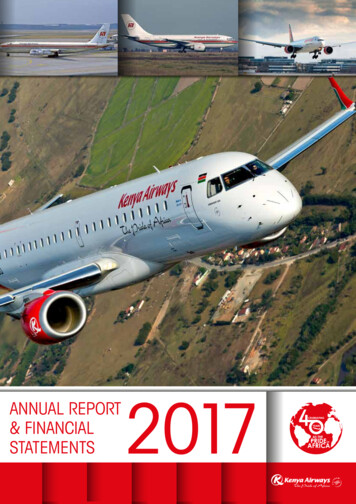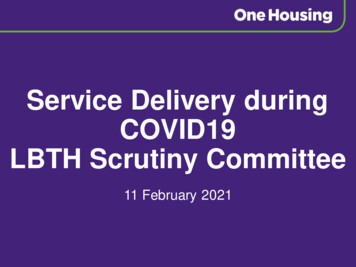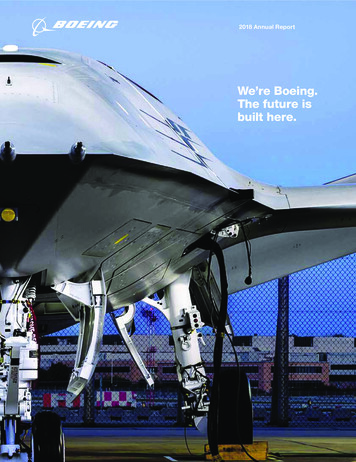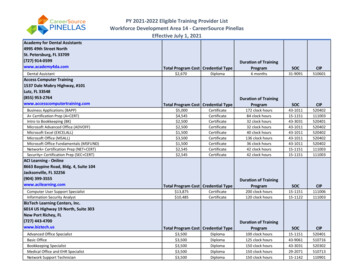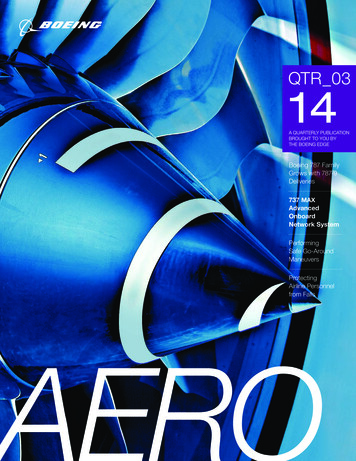
Transcription
QTR 0314A QUARTERLY PUBLICATIONBROUGHT TO YOU BYTHE BOEING EDGEBoeing 787 FamilyGrows with 787-9Deliveries737 MAXAdvancedOnboardNetwork SystemPerformingSafe Go-AroundManeuversProtectingAirline Personnelfrom Falls
Cover photo: 787 Engine
AEROContents03Boeing 787 Family Growswith 787-9 DeliveriesDelivery of the first 787-9 marks an excitingnew phase for the 787 family.05737 MAX Advanced OnboardNetwork SystemThe new 737 onboard network systemconnects airline operations andmaintenance with key airplane dataand software parts.0513Performing Safe Go-AroundManeuvers13Flight crews must be aware of thedifficulties that can occur in a go-aroundmaneuver and follow appropriateprocedures to address those difficulties.19Protecting Airline Personnelfrom FallsOpen doors, access panels, and hatcheson parked airplanes can be potential safetyhazards for airline maintenance personnel.Investigations by Boeing indicate thatincidents are preventable by proper andconsistent use of barriers and followingairline policies and procedures.19W W W . BOEING.COM/BO E ING E D G E / A E RO M A G A ZINEIssue 55 Quarter 03 201401
AEROEditorial directorDesignCover photographyEditorial BoardJill LangerMethodologieJeff CorwinDon Andersen, Gary Bartz, Richard Breuhaus, David Carbaugh, Laura Chiarenza,Editor-in-chiefWriterPrinterJim LombardoJeff FragaColorGraphicsDistribution managerWeb site designNanci MoultrieMethodologieJustin Hale, Darrell Hokuf, Al John, Doug Lane, Jill Langer, Duke McMillin,Keith Otsuka, David Presuhn, Wade Price, Jerome Schmelzer, Corky TownsendTechnical Review CommitteeGary Bartz, Richard Breuhaus, David Carbaugh, Laura Chiarenza, Justin Hale,Darrell Hokuf, Al John, David Landstrom, Doug Lane, Jill Langer, Duke McMillin,David Presuhn, Wade Price, Jerome Schmelzer, Corky Townsend, William TsaiAERO Onlinewww.boeing.com/boeingedge/aeromagazineThe Boeing Edgewww.boeing.com/boeingedgeAERO magazine is published quarterly by Boeing Commercial Airplanes and isdistributed at no cost to operators of Boeing commercial airplanes. AERO providesoperators with supplemental technical information to promote continuous safetyand efficiency in their daily fleet operations.The Boeing Edge supports operators during the life of each Boeing commercialairplane. Support includes stationing Field Service representatives in more than60 countries, furnishing spare parts and engineering support, training flight crewsand maintenance personnel, and providing operations and maintenance publications.Boeing continually communicates with operators through such vehicles as technicalmeetings, service letters, and service bulletins. This assists operators in addressingregulatory requirements and Air Transport Association specifications.Copyright 2014 The Boeing CompanyInformation published in AERO magazine is intended to be accurate and authoritative.However, no material should be considered regulatory-approved unless specifically stated.Airline personnel are advised that their company’s policy may differ from or conflict withinformation in this publication. Customer airlines may republish articles from AEROwithout permission if for distribution only within their own organizations. They therebyassume responsibility for the current accuracy of the republished material. All othersmust obtain written permission from Boeing before reprinting any AERO article.Print copies of AERO are not available by subscription, but the publication maybe viewed on the Web at www.boeing.com/boeingedge/aeromagazine.Please send address changes to csms.catalog@boeing.com. Please send all othercommunications to AERO Magazine, Boeing Commercial Airplanes, P.O. Box 3707,MC 21-72, Seattle, Washington, 98124‑2207, USA.E-mail: WebMaster.BCA@boeing.comAERO is printed on Forest Stewardship Council Certified paper.02AER O Q UAR T ER LY QT R 03 14
Boeing 787 Family Growswith 787-9 DeliveriesBoeing is proud to have delivered the first787-9 Dreamliner to our valued partner andlaunch customer Air New Zealand in June.As they say in New Zealand, the deliverywas “good as gold,” with some 1,000 Boeingemployees representing the 787 programjoining Air New Zealand executives andguests in July at a unique celebration ofthe milestone.Our delivery of the first 787-9 is a tributeto our partnership with Air New Zealandand all of our 787-9 customers and the hardwork and dedication of the entire global 787team, which worked tirelessly to achievedevelopment, testing, and certificationmilestones for the 787-9 throughout thedevelopment process.The delivery also marks an exciting newphase for the 787 family as we continue toramp up 787-9 production and deliveries toyou, our customers. Boeing delivered thefirst 787-9 powered by General ElectricGEnx engines to United Airlines earlier thismonth and recently began production ofthe 13th 787-9.W W W . BOEING.COM/BO E ING E D G E / A E RO M A G A ZINEWith its outstanding fuel performance,lower environmental emissions, andpreferred passenger experience, the 787-9leverages the visionary design of the 787-8and additional innovations to bring a newlevel of efficiency to the market.For starters, the 787-9 offers the flexibilityto accommodate up to 40 percent morepassengers, 23 percent more cargo, or450 more nautical miles in range. Yet the787-9 also offers the same exceptionalenvironmental performance as the 787-8:20 percent less fuel use and 20 percentfewer emissions than the airplanes itreplaces. It’s the perfect complement togrow routes first opened by the 787-8.As we work closely with operators tointroduce the 787-9 into operations andto passengers around the world, wethank you for your continued partnership.LARRY LOFTISVice President and General Manager,787 ProgramBoeing Commercial Airplanes03
The 737 MAX featuresan advanced ONS withcomponents developedand tested on theNext‑Generation 737with 737 MAX features.04AER O Q UAR T ER LY QT R 03 14
737 MAX AdvancedOnboard Network SystemThe new 737 MAX is designed to enhance and extend the Next-Generation 737 whilemaintaining commonality with the previous models. One of the ways Boeing is advancingthe data capabilities of the 737 MAX is by providing an onboard network system (ONS)architecture that securely connects airline operations and maintenance with keyairplane data and software parts. Some ONS capabilities also will be made available onNext‑Generation 737 airplanes via selectable options. This system increases data availableto the airline and provides that data to the crew and the airline’s ground infrastructure.By Victoria Wilk, Manager, 737 Network Systems and Connectivity, andTri M. Phan, Associate Technical Fellow, Network Systems and ConnectivityBoeing is improving the 737 by addinga new onboard network system (ONS) toconnect airline operations and maintenancewith airplane data and software parts.ONS vastly increases data available to theairline, and the ONS connectivity systemsprovide that data and airplane software tothe flight, cabin, and main tenance crews,and the ground. The systems meet stringentU.S. Federal Aviation Admin istration(FAA) requirements for a safe and secureairborne network.Together, ONS and ONS connectivitysystems consolidate functions typicallyperformed by multiple line replace able units(LRUs). Basic and optional componentsmake ONS scalable to current operationaldemand as well as flexible enough to growfor future operational needs. Many ONScomponents are being introduced on theNext-Generation 737, prior to the first737 MAX delivery.This article describes the architectureand the advantages of the ONS on the737 MAX and Next-Generation 737.W W W . BOEING.COM/BO E ING E D G E / A E RO M A G A ZINEDESIGNING FOR ADVANCEDOPERATIONS AND MAINTENANCEAn integral part of Boeing’s continuousimprovement of the 737 family of productsis listening to and responding to customerneeds. Many operators have asked thatthe 737 MAX include access to additionalairplane data, and that data be securelymade available to flight, cabin, andmaintenance teams during flight or whileon the ground.05
Figure 1: Enhanced capabilities of airplane systemsThe onboard network system integrates data-rich airplane systems with optionalconnectivity systems to make the 737 MAX a node on the airline’s data network.ConnectivityCrew WirelessGround-Based ConnectivityAirborne Broadband Internet ProtocolData LinksBoeing has responded with ONS:a network of on-airplane systems thatcollects a high volume of airplane dataand makes that data available to the airline.ONS integrates data-rich airplane systemswith optional connectivity systems to makethe 737 MAX a node on the airline’s net work. 737 MAX airplanes equipped withONS allow an airline to seamlessly supportmore efficient maintenance tasks andoperational procedures.06In addition, ONS consolidates existingfunctions typically performed by severaloptional systems and expands capability.ONS integrates dataload, airplane datarecording, and system troubleshooting ontoa single system, and enables integration ofoperations functions typically performed bythe crew on mobile or electronic flight bag(EFB) devices (see fig. 1).ONS is a scalable architecture. Optionalconnectivity systems and software appli cations that further leverage the capabilityof ONS may be selected to evolve a 737fleet on the airline’s timeline.ONS may also be combined with Boeingservices to leverage an airplane’s largevolume of data for advanced maintenanceplanning. ONS enables expansion of manycurrently offered capabilities and newcapabilities. How airlines may maximizeONS using Boeing service offerings will bethe focus of an upcoming issue of AERO.AER O Q UAR T ER LY QT R 03 14
Onboard NetworkOnboard Network System File ServerEnhanced Digital Flight DataAcquisition Unit737 MAX Display SystemFlight and Cabin FunctionalityDataloadAirplane Data RecordingEngine Health ManagementCentralized Flight Deck MaintenanceSecure Air-to-Ground Communicationprovided by a flight deck Ethernet portor by optional connectivity systems.The ONS file server is available on theNext‑Generation 737.THE ONBOARD NETWORKOn the 737 MAX, the hardware most centralto the ONS is a part of the basic airplane. ONS file server. The ONS file server is thehub of the 737 MAX onboard network.Housed in the electronics equipmentbay, the ONS file server connects to alarge set of data-rich 737 systems,houses hundreds of gigabytes of massdata storage, sends mainte nance data toflight deck displays, and hosts onboardand offboard data processing functions.Direct connection to the ONS file servervia the airline’s maintenance device is Enhanced digital flight data acquisitionunit (DFDAU). A new DFDAU greatlyincreases the availability of airplane datato be used for onboard functions andoffboard analytics. This DFDAU makes100 times more data available than thelegacy equipment it replaces.737 MAX display system. The 737 MAXdisplay system will be connected to theONS file server to further increase dataW W W . BOEING.COM/BO E ING E D G E / A E RO M A G A ZINEavailability and to enable flight deckdisplay of maintenance information onthe 737 MAX large-format displays. Thissystem is basic hardware that in thefuture will enable display of operationalinformation data, such as EFB data.CONNECTING TO THE CREW ANDTHE GROUNDSeveral connectivity systems are availableon the 737 MAX to connect the onboardnetwork to the crew and to the airlineground infrastructure.07
Figure 2: Onboard network system availability timelineTo maximize common operations, the system available on the Next-Generation 737 is equippedwith connections to the same or equivalent data-rich systems as the 737 MAX ONS.OnboardNetworkSystemProvisionsNext-Generation 737File ServerFourth Quarter2013Third Quarter 20142014Next-Generation737 ONS FileServer Provisions2015Next-Generation 737ONS File ServerCrewWirelessONSQuick AccessRecorderEngine Trim ware DataLoading*Secure DataDistributionAirplane DataMonitoring* StandardOptional* Standard when 737 ONS file server is selected 08Crew wireless. This connectivity systemprovides a secure on-airplane WiFi net work for crew and ground/maintenanceuse, both in-flight and at the gate. Thissystem may integrate with crew mobiledevices to leverage the ONS for paper lessoperational and maintenance procedures.Ground-based connectivity. This broad band Internet protocol (IP) connectivitysystem makes the airplane capable ofwireless transfer of airplane data or soft ware parts between the ONS file serverand the airline’s ground-based officesusing secure WiFi or cellular connectionswhile the airplane is on the ground. Airborne broadband IP data links.The ONS is capable of integration withIP-based satellite connectivity systems,such as L-band, Ku, and Ka satellitecommunication systems, to allow securehigh-speed data transfer during flight.connectivity, ONS consolidates a powerfulset of capabilities including dataload,airplane data recording, system faultreporting, and health management ontoa single integrated system.FUNCTIONALITY CONSOLIDATIONCOMMONALITY WITH NEXTGENERATION 737 FLEETIn addition to collecting and connectingmore data to the airline’s net work, the ONShosts software applications that enhancefunctions hosted by multiple sys tems oncurrent Next-Generation 737 models, aswell as applications that per form newcapabilities. Particularly when paired withTo maximize common operations betweenthe Next-Generation 737 and 737 MAXfleets, many components of ONS will beoffered and available for retrofit on theNext-Generation 737. The system availableon the Next-Generation 737 is equippedwith connections to the same or equivalentAER O Q UAR T ER LY QT R 03 14
737 MAX Onboard Network System737 MAX launches in 20172016Upgraded ONSFile Server2017Enhanced DigitalFlight DataAcquisition UnitMAXDisplay SystemUpgraded ONSFile ServerEnhanced DigitalFlight DataAcquisition UnitCentralized FlightDeck MaintenanceEngine HealthMonitoringdata-rich systems as the 737 MAX ONS,and most of the same capabilities are sup ported. Centralized flight deck maintenanceand engine health management are exclu sive to the 737 MAX. See Figure 2 for aroadmap of production availability ofsystems on the Next-Generation 737 andthe 737 MAX.Functionality coming to the NextGeneration 737 and the 737 MAX Software data loading. The ONS file serveris connected to all data-loadable systemson the 737 MAX. ONS is unique in itscapability to load software parts over highspeed Ethernet, greatly decreasing thetime required to load Ethernet-enabledsystems such as the display system. Airplane data recording. More than75 flight hours of operational data foronboard and offboard analytics,including legacy quick access recorderdata, may be collected on the ONS fileserver mass storage. This ONS fileserver-hosted functionality is called ONSQuick Access Recorder (ONS QAR).Secure data and software distribution.ONS enables the distribution of airplanedata or software parts between theairplane and airline (e.g., software partstaging to the airplane from the airline).When paired with a connectivity systemand ground-based system integrationsoftware, ONS may perform securewireless electronic distribution ofW W W . BOEING.COM/BO E ING E D G E / A E RO M A G A ZINEsoftware and airplane data between theairplane and airline. Crew operations. Crew applicationsrunning on portable maintenance devices,such as tablets, may connect to the ONSfile server for services such as onboardstorage, printing, airplane data, andoffboard connectivity. An ONS softwaredevelopment kit will allow air lines to buildcustom software applications tailoredto specific operational needs. Customsoftware applications may be hostedon an airline tablet that connects to theONS data and connectivity network.09
Figure 3: Centralized flight deck maintenanceThe onboard maintenance function will help reduce no-fault-found events.Functionality available exclusively on the737 MAX 10Centralized flight deck maintenance.The ONS and the MAX display systemintegrate airplane data collected duringflight with a new onboard maintenancefunction that consolidates maintenancedata for view on the flight deck displaysand on portable mainte nance devices,such as tablets. Data displayed in theflight deck includes system dispatchstatus, existing faults, initiated tests, con figuration reporting, and maintenancepage information (see fig. 3).The onboard maintenance functionwill be capable of reducing no-faultfound events by correlating systemstatus indications to detailed system andequipment faults and will also allow forfault forwarding downlinks. Central izingthe display of this infor mation allows thecreation of common main tenanceprocedures and allows mechanics toperform maintenance and fault isolationtasks for each of the 737 MAX systemswithout accessing them individually inthe electronics equipment bay. Central ized flight deck main tenance combineswith the 737 MAX displays systemupgrade and upgrades in other systemsto create an advanced flight deckenvironment that is flexible enough tomanage maintenance tasks formerlylimited to the electronics equipment bayand enables more focused maintenancetroubleshooting. Engine health monitoring. On the737 MAX, the functions of the airbornevibration monitor and engine electroniccontrol will be integrated into a singleLRU. ONS integration with the engineelectronic control will bring advancedengine health management functionsto the 737 MAX, including enhancedtrim balance, prognostics reports, andAER O Q UAR T ER LY QT R 03 14
Status MessagesMaintenance Page MenuAir Conditioning Maintenance PageInbound Flight Deck EffectsMaintenance Message DetailsPresent Leg Faultsincreased engine data collection forin-service maintenance support andperformance analysis.LEVERAGING BOEING COMMERCIALAVIATION SERVICESA SECURE NETWORKAs connected airspace evolves, the737 MAX will be equipped with securitymeasures to protect airplane and passen ger information that is transferred on andoff the airplane. The 737 MAX ONS willmeet FAA data security guidances to createa safe and secure airborne network.The quantity of data made available by the737 MAX ONS facilitates advances in allaspects of operations, including mainte nance, engineering, and ground operations.For example, an airline maintenance teammay leverage data collected across the737 MAX fleet for predictive maintenanceanalytics. An ONS-connected airplane willbe able to take advantage of services fromBoeing that can further optimize airplaneoperations. How airlines can maximize ONSW W W . BOEING.COM/BO E ING E D G E / A E RO M A G A ZINEcapability will be the focus of an upcomingissue of AERO.SUMMARYThe new 737 MAX features an advancedONS that combines components devel oped and tested on the Next-Generation737. The new ONS is a secure, scalable,and integrated architecture that enablessignificant operational and maintenanceefficiencies by connecting critical airplanedata with the airline and its groundinfrastructure.A11
A go-around maneuverperformed accordingto standard operatingprocedures by crews canbe effective and safe.12AER O Q UAR T ER LY QT R 03 14
Performing SafeGo-Around ManeuversA go-around maneuver may be performed in a number of situations, including whenrequested by air traffic control (ATC) or when an airplane is making an unstabilizedapproach. Once a go-around decision has been made, flight crews must focus on ensuringthat the maneuver is flown correctly by being aware of the difficulties that can occur andfollowing the appropriate procedures to address those difficulties. A go-around maneuvercan be both effective and safe when performed according to standard operatingprocedures by crews who are alerted to possible hazards.By David Carbaugh, Chief Pilot, Flight Operations Safety, andBertrand de Courville, Captain, Air France, Retired, and Co-Chair, European Commercial Aviation Safety TeamPerforming a go-around is the best decisionto make whenever the safety of an approachor a landing appears to be compromised.While the go-around maneuver shouldbe a normal and well-trained procedure,difficulties can occur. This article focuseson some of the problems flight crews canexperience when executing a go-aroundmaneuver and how they can address theseproblems to make the maneuver safer.THE NATURE OF GO-AROUNDMANEUVERSAlthough only 3 percent of commercialairplane landing approaches meet thecriteria for being considered unstabilized,97 percent of these unstabilized approachesare continued to a landing, contrary toairline standard operating procedures. (SeeAERO second-quarter 2014.) In many ofthese cases, a go-around maneuver shouldhave been performed.Go-around maneuvers are often per formed at low altitude, low speed, andsometimes very close to the ground. Asignificant number of actions must be per formed in a short period of time, and all ofthem are related to important changesof attitude, thrust, flight path, airplaneconfiguration (i.e., flaps and gear), andpitch trim. Each of these actions must becarefully monitored and cross-checked.Automation has brought additionalchecks related to autopilot, flight director,W W W . BOEING.COM/BO E ING E D G E / A E RO M A G A ZINEand autothrottle modes, all of which needto be read, checked, and announced bypilots during the go-around. At the sametime, ATC can add to the flight crew’sworkload by requesting information aboutthe cause of the go-around, crew inten tions, and sometimes issuing frequencychanges. Even without being asked byATC, a pilot may feel the need to commu ni cate immediately with ATC. The capacitiesof both the pilot flying (PF) and pilot moni toring (PM) to manage priorities during thisphase follow the safety adage of “aviate,navigate, communicate — in that order.”All of these factors explain why the goaround maneuver needs to be approachedwith care. Airlines should also use data13
Handling extreme nose-up incidentsBoeing, in concert with the aviation industry, has developed a nose-high upset recovery procedure that pilots should perform if theyencounter this situation.Pilot FlyingRecognize and confirm the situation. Disconnect autopilot and autothrottle. Apply as much as full nose-down elevator. Apply appropriate nose-down stabilizer trim. Reduce thrust. Roll (adjust bank angle) to obtain a nose-down pitch rate. Complete the recovery: when approaching the horizon, roll to wings level, checkairspeed, and adjust thrust. Establish pitch attitude. Pilot MonitoringRecognize and confirm the situation. Call out attitude, airspeed, and altitude throughout the recovery. Verify all required actions have been completed and call out any omissions. monitoring programs to better detect andanalyze such events.TWO PRIMARY ISSUES RELATED TOGO-AROUND MANEUVERSWhen there are incidents related to goaround maneuvers, they are usually the resultof excessive pitch-up or pitch-down attitude.Extreme nose-up attitude. These events,which typically result from a particularcombination of go-around thrust, speed,and nose-up trim, are characterized bya lack of pitch-down control authority atthe beginning of the go-around. Theyaccount for a number of scenarios inwhich a go-around is initiated after a speedexcur sion well below the approach speed,long enough to have a trim moving into anunusual nose-up setting. The increase ofthrust combined with the nose-up trim mayresult in loss of control. The Airplane UpsetRecovery Training Aid (Rev. 2) has beendeveloped by manufacturers to addressthese situations. (See “Handling extremenose-up incidents” above.)14One example occurred in the UnitedKingdom. On final approach, the airplaneslowed to near the stall speed. Becausethe autopilot was still engaged, thestabilizer trim was very nose up tocompensate for the reduced speed onapproach. When the crew noticed the slowspeed and decided to do a go-around,the combination of pitch-up contributionsof the engines, stabilizer, and slow speedmade the nose pitch up, and the crew wasunable to arrest the pitch-up with elevatoronly until the airplane stalled. Fortunately,the nose fell straight ahead and the airplanerecovered; it would have pitched up againexcept that the crew intervened with nosedown stabilizer input.Extreme nose-down attitude. Since 2000,several incidents have involved extremenose-down attitudes during the go-aroundmaneuver on different types of airplanesfrom different manufacturers. These inci dents often result from a breakdown incorrect cockpit instrument scanning. Hereare some examples: After the PF initiated a manual go-aroundat night over the sea, at 1,000 feet(305 meters), the PF kept a prolongedpitch-down input resulting in a 15-degreenose-down attitude and a dive that wasnot recovered before the impact with thesea. The amplitude and duration of theinitial reaction by the PF to the “pull-up”warn ing from the ground proximity warn ing system (GPWS) was insufficient(i.e., a full back stick input was required).After the PF initiated a manual go-aroundin instrument conditions, and approach ing 2,500 feet (762 meters), the flightdirector altitude capture mode wasactivated earlier than expected by thecrew because of a high rate of climb.The PF manually initiated a level-offbut kept a prolonged pitch-down inputthat resulted in a dive that reachedan extreme negative attitude (minus40 degrees). The PF recovered fromthe dive at about 400 feet (122 meters)above the ground with a vertical accel eration of 3.6 g-force (g).AER O Q UAR T ER LY QT R 03 14
Handling extreme nose-down incidentsBoeing, in concert with the aviation industry, has developed a nose-down upset recovery procedure that pilots should perform if theyencounter this situation.Pilot FlyingRecognize and confirm the situation. Disconnect autopilot and autothrottle. Recover from stall, if required. Roll in shortest direction to wings level (unload and roll if bank angle is more than90 degrees). Recover to level flight. Apply nose-up elevator. Apply nose-up trim, if required. Pilot MonitoringRecognize and confirm the situation. Call out attitude, airspeed, and altitude throughout the recovery. Verify all required actions have been completed and call out any omissions. Source: From the flight maneuvers section of the quick reference handbook flight manual andadapted from the Airplane Upset Recovery Training Aid (Rev. 2) After the PF initiated a manual go-aroundat night over the sea, the altitude acqui sition mode activated while approachingthe selected altitude and the PF pitcheddown to level off. The indicated airspeedincreased toward the maximum for theconfiguration. Instead of leveling off, thePF kept a prolonged pitch-down input.The attitude quickly decreased andreached a negative 9-degree pitch witha vertical speed of 4,000 feet (1,219meters) per minute. When the GPWSactivated, the PF reacted by pitching theairplane up. The minimum altitude was600 feet (183 meters) over the sea. Thetotal duration of the event was about15 seconds. Neither pilot could explainthe reason for the upset.In all of these examples, pilots reactedvery late to extreme negative attitudesdisplayed on both attitude director indicator(ADI) instruments. All of these eventshappened at night over a dark area or ininstrument meteorological conditions. Atthe time of the upset, in the absence ofvisual reference, the only attitude infor mation was provided by the ADIs. Whenflying manually or when monitoring the auto pilot, the ADIs are at the center of a controlprocess in which pilots must detect andthen quickly and accurately correct devia tions from targeted values. (See “Handlingextreme nose-down incidents” above.)A reasonable explanation for this initiallack of pilot reaction is that both pilotsbecome distracted from monitoring theADIs at the time of a pilot nose-down input.When pilots are distracted, an airplanecould change its flight path from a normalgo-around climb to a steep dive in fewerthan 10 seconds.It may appear that such a deep divewould be perceived physically by the flightcrew, without need of instruments. How ever, at constant thrust, any significantnose-down attitude reduction will createacceleration. The physical effect of theresulting acceleration corresponds exactlyto the perception of attitude change. Bothpilots, unless they look at their instruments,will believe they are climbing while theirairplane has entered a deep dive (i.e., thepilots’ mental picture is becoming inaccu rate) (see fig. 1). When the pilots return toW W W . BOEING.COM/BO E ING E D G E / A E RO M A G A ZINEtheir instruments, what they read willconflict with their mental picture of theairplane attitude. This causes cognitiveconfusion and potentially severe spatialdisorientations. Poor or disrupted pilotinstrument scannings may lead to asomatogravic illusion, which is presentduring high accelerations or decelerationswhen a pilot has no clear visual reference.A somatogravic illusion is when the humansenses of the pilot cause spatial disorien tation about the actual airplane movement.THE NORMAL AND ESSENTIALINSTRUMENT SCANAll pilots trained on instrument flight ruleslearn the T-shape principle of basicinstruments scan (see fig. 2). The attitudeindication (i.e., pitch and roll information)is at the center of the instrument flying ormonitoring process during dynamic phases.From the center of the ADI, the pilot’s focusmoves successively to speed, altitude,vertical speed, and heading indi cation —all of which are directly dependent on theairplane attitude presented by the ADI.15
Figure 1: Spatial disorientation can confuse pilotsA situation known as somatogravic illusion can occur when an airplane accelerates. If the pilots lose track of visual references and are not looking atinstruments, they perceive that the airplane is nosing up, when in fact, it is entering a deep dive.INSTRUMENT SCAN BREAKDOWNSOURCES:Somatogravic,ot
launch customer Air New Zealand in June. As they say in New Zealand, the delivery was "good as gold," with some 1,000 Boeing employees representing the 787 program joining Air New Zealand executives and guests in July at a unique celebration of the milestone. Our delivery of the first 787-9 is a tribute to our partnership with Air New Zealand

